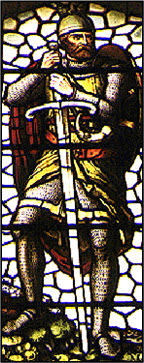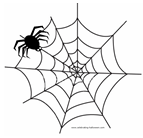


ROBERT BRUCE, KING OF SCOTLAND 1306 -
Life 1274 -
xxxxxAs we have seen, the Battle of Falkirk in 1298 put an end to the hopes of William Wallace for an independent Scotland, but in 1306 Robert Bruce, a one-
xxxxxAs we have seen, following the defeat of the Scottish King John Balliol by an English army at the Battle of Dunbar in 1296, William Wallace assumed the leadership of the independence movement. Two years later, however, in 1298 he was himself defeated at the Battle of Falkirk. All seemed lost, but another patriotic leader was about to take the stage.
 xxxxxFollowing the capture and execution of Wallace, Robert Bruce, who, as the Earl of Carrigan had paid homage to Edward, was selected as one of the four regents to govern the kingdom in the name of John Balliol. On the 10th February 1306, however, he got into a quarrel with John Comyn, the cousin of John Balliol and a possible contender for the throne. During their meeting, which took place in Greyfriars Church at Dumfries, Comyn was stabbed to death by Bruce. The motive for the killing was not difficult to find because Bruce then made straight for Scone Abbey and was crowned king of Scotland the following month, 1306.
xxxxxFollowing the capture and execution of Wallace, Robert Bruce, who, as the Earl of Carrigan had paid homage to Edward, was selected as one of the four regents to govern the kingdom in the name of John Balliol. On the 10th February 1306, however, he got into a quarrel with John Comyn, the cousin of John Balliol and a possible contender for the throne. During their meeting, which took place in Greyfriars Church at Dumfries, Comyn was stabbed to death by Bruce. The motive for the killing was not difficult to find because Bruce then made straight for Scone Abbey and was crowned king of Scotland the following month, 1306.
xxxxxEdward acted at once. He deposed Bruce and ordered his forces in Scotland to hunt the traitor down. They defeated Bruce in two battles in that year, and captured many of his supporters and relatives, including his wife and three of his brothers. Bruce managed to escape, but was forced to flee the mainland, taking refuge in the little island of Rathlin off the coast of Antrim in northern Ireland.
xxxxxIn February 1307 he returned to Ayrshire, hoping to drum up enough support to oppose and beat off the inevitable English challenge. But the challenge never came. Edward mustered an army and travelled north to re-
xxxxxAs we shall see, the death of the “Hammer of the Scots” was good news for Bruce, made all the better by the succession of his son, the feeble and inept Edward II. The fight for Scottish independence was far from over. As we shall see, at the Battle of Bannockburn in 1314 (E2) the English were to suffer a humiliating defeat at the hands of Robert Bruce and his determined army.
 xxxxxIncidentally, it was while Bruce was in hiding in a cave on the small, remote island of Rathlin that, so the story goes, he saw a spider making its web. He was so impressed with the spider’s determination and perseverance in completing the work that he vowed he would carry on the fight for Scottish independence no matter what the cost. Sadly, it is not a likely story.
xxxxxIncidentally, it was while Bruce was in hiding in a cave on the small, remote island of Rathlin that, so the story goes, he saw a spider making its web. He was so impressed with the spider’s determination and perseverance in completing the work that he vowed he would carry on the fight for Scottish independence no matter what the cost. Sadly, it is not a likely story.
E1-
Acknowledgement
Robert Bruce: stained-


